Visco-Elastic Interface Effect on the Dynamic Stress of Symmetrical Tunnel Embedded in a Half-Plane Subjected to P Waves
Abstract
:1. Introduction
2. Problem Formulation and Basis Solutions
3. Wave Fields in the Rock Mass and Concrete Lining
3.1. The Incident Waves
3.2. The Scattered Field in the Half-Plane
3.3. The Reflected Field in the Tunnel Lining
3.4. The Refracted Field Inside the Tunnel Lining
3.5. The Wave Fields from the Half-Plane
3.6. The Total Displacement Potential in the Half-Plane and Concrete Tunnel
4. Boundary Conditions and Solving the Expanded Coefficients
5. Numerical Examples and Analysis
6. Conclusions
Author Contributions
Funding
Data Availability Statement
Conflicts of Interest
Appendix A
References
- Huang, L.; Liu, Z.; Wu, C.; Liang, J. Interaction between a tunnel and alluvial valley under plane SV waves of earthquakes by IBIEM. Eur. J. Environ. Civ. Eng. 2021, 25, 2217–2235. [Google Scholar] [CrossRef]
- Jin, H.-X.; Fang, X.-Q.; Wang, Y.; Wang, B.-L. Interaction of two shallow non-circular tunnels with imperfect interfaces subjected to shear waves. Eur. J. Environ. Civ. Eng. 2018, 22, 546–561. [Google Scholar] [CrossRef]
- Yi, C.; Zhang, P.; Johansson, D.; Nyberg, U. Dynamic response of a circular lined tunnel with an imperfect interface subjected to cylindrical P-waves. Comput. Geotech. 2014, 55, 165–171. [Google Scholar] [CrossRef]
- Pao, Y.-H.; Mow, C.-C.; Achenbach, J.D. Diffraction of Elastic Waves and Dynamic Stress Concentrations. J. Appl. Mech. 1973, 40, 872. [Google Scholar] [CrossRef] [Green Version]
- Liu, D.; Gai, B.; Tao, G. Applications of the method of complex functions to dynamic stress concentrations. Wave Motion 1982, 4, 293–304. [Google Scholar] [CrossRef]
- Zhou, C.; Hu, C.; Ma, F.; Liu, D. Elastic wave scattering and dynamic stress concentrations in exponential graded materials with two elliptic holes. Wave Motion 2014, 51, 466–475. [Google Scholar] [CrossRef]
- Sancar, S.; Pao, Y. Spectral analysis of elastic pulses backscattered from two cylindrical cavities in a solid. Part I. J. Acoust. Soc. Am. 1981, 69, 1591–1596. [Google Scholar] [CrossRef]
- Moore, I.D.; Guan, F. Three-dimensional dynamic response of lined tunnels due to incident seismic waves. Earthq. Eng. Struct. Dyn. 2015, 25, 357–369. [Google Scholar] [CrossRef]
- Mohsen, K.; Mohammad, A.; Hamid, A. Seismic ground amplification by unlined tunnels subjected to vertically propagating SV and P waves using BEM. Soil Dyn. Earthq. Eng. 2015, 71, 63–79. [Google Scholar]
- Wang, T.-T.; Hsu, J.-T.; Chen, C.-H.; Huang, T.-H. Response of a tunnel in double-layer rocks subjected to harmonic P- and S-waves. Int. J. Rock Mech. Min. Sci. 2014, 70, 435–443. [Google Scholar] [CrossRef]
- Liu, Q.; Wang, R. Dynamic response of twin closely-spaced circular tunnels to harmonic plane waves in a full space. Tunn. Undergr. Space Technol. 2012, 32, 212–220. [Google Scholar] [CrossRef]
- Krutin, V.; Markov, M.; Yumatov, A. Normal waves in a fluid-filled cylindrical cavity located in a saturated porous medium. J. Appl. Math. Mech. 1988, 52, 67–74. [Google Scholar] [CrossRef]
- Wang, J.; Zhou, X.; Lu, J. Dynamic stress concentration around elliptic cavities in saturated poroelastic soil under harmonic plane waves. Int. J. Solids Struct. 2005, 42, 4295–4310. [Google Scholar] [CrossRef]
- Chris, Z. Scattering of plane compressional waves by spherical inclusions in a poroelastic medium. J. Acoust. Soc. Am. 1993, 94, 527–536. [Google Scholar]
- Kattis, S.E.; Beskos, D.E.; Cheng, A.H.D. 2D dynamic response of unlined and lined tunnels in poroelastic soil to harmonic body waves. Earthq. Eng. Struct. Dyn. 2003, 32, 97–110. [Google Scholar] [CrossRef]
- Sedarat, H.; Kozak, A.; Hashash, Y.; Shamsabadi, A.; Krimotat, A. Contact interface in seismic analysis of circular tunnels. Tunn. Undergr. Space Technol. Inc. Trenchless Technol. Res. 2009, 24, 482–490. [Google Scholar] [CrossRef]
- Lu, A.Z.; Zhang, L.Q. Complex Function Method on Mechanical Analysis of Underground Tunnel; Science Press: Beijing, China, 2007. [Google Scholar]
- Liu, Q.; Zhao, M.; Wang, L. Scattering of plane P, SV or Rayleigh waves by a shallow lined tunnel in an elastic half space. Soil Dyn. Earthq. Eng. 2013, 49, 52–63. [Google Scholar] [CrossRef]
- Ivanov, Y.A. Diffraction of Electromagnetic Waves on Two Bodies; National Aeronautics and Space Administration: Washington, DC, USA, 1970. [Google Scholar]
- Kargar, A.; Rahmannejad, R.; Hajabasi, M. A semi-analytical elastic solution for stress field of lined non-circular tunnels at great depth using complex variable method. Int. J. Solids Struct. 2014, 51, 1475–1482. [Google Scholar] [CrossRef] [Green Version]
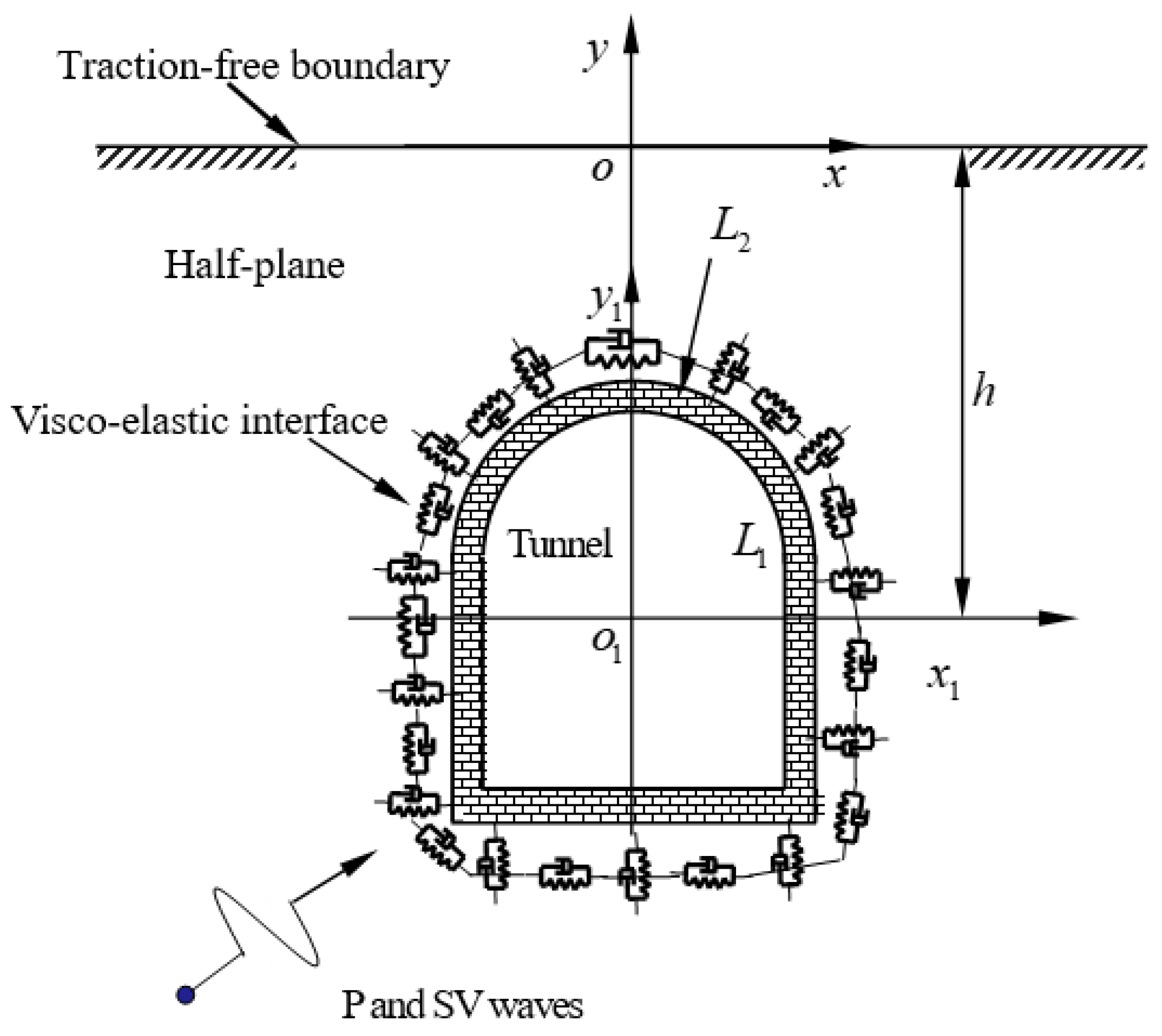
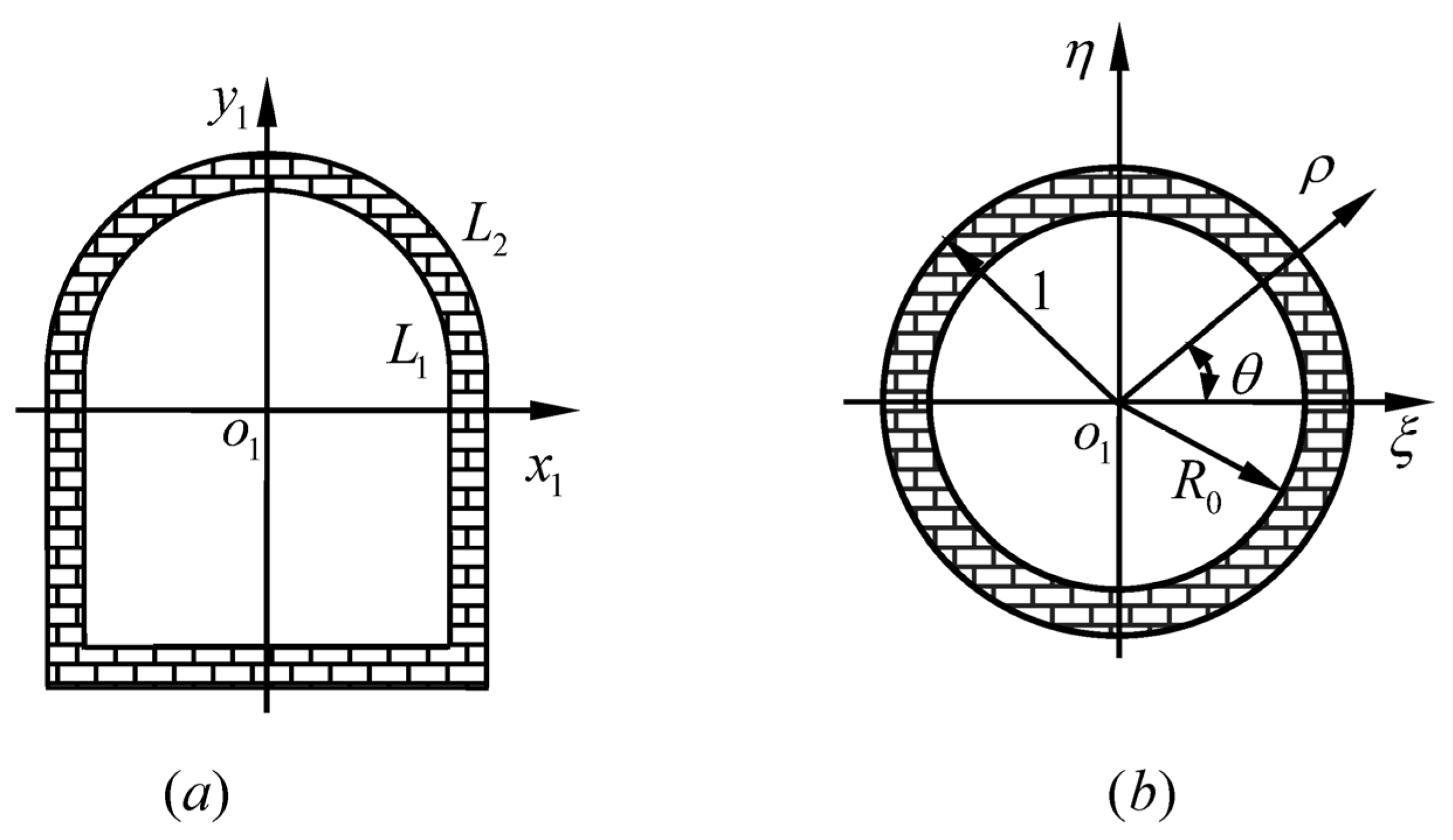



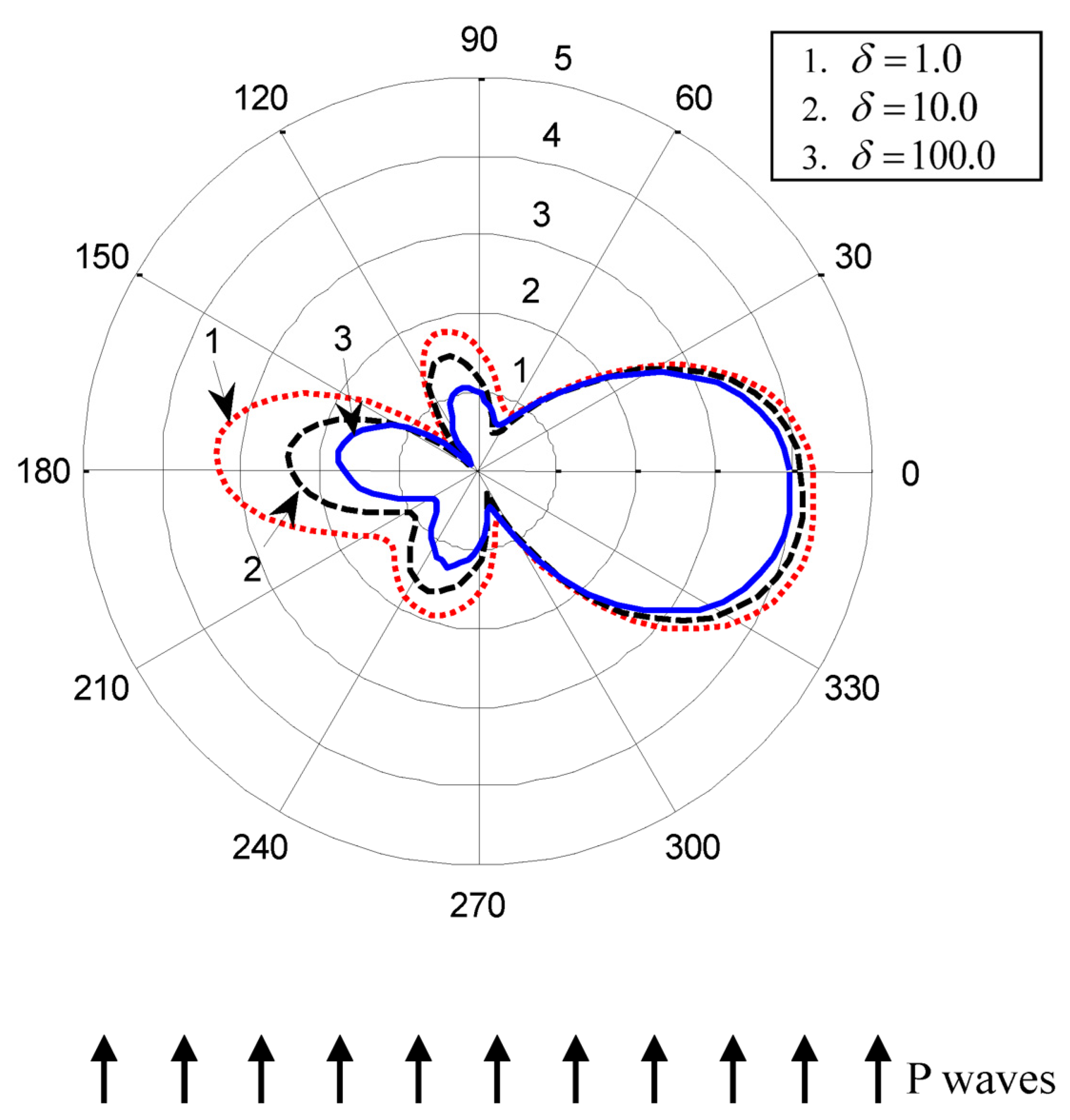

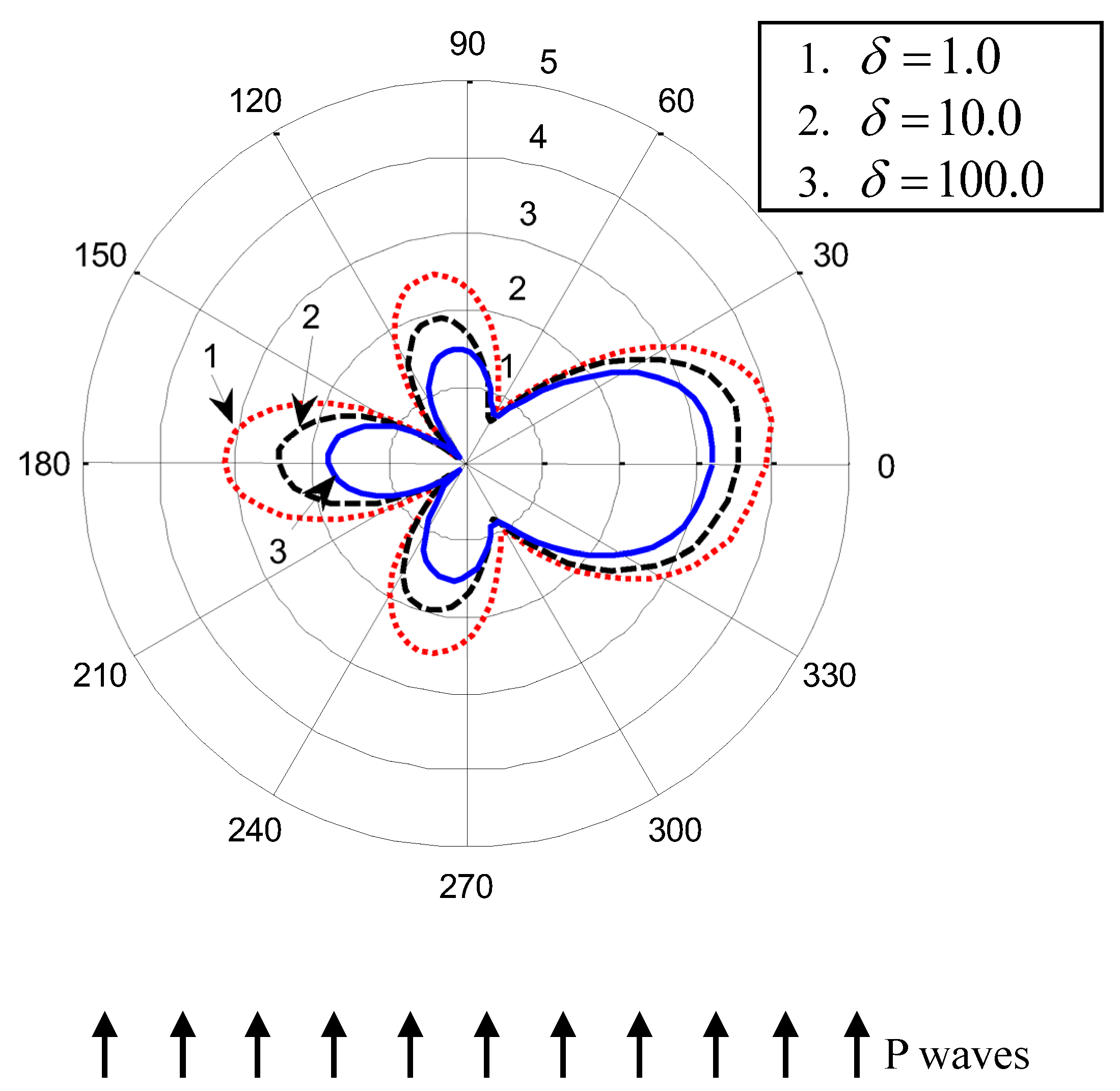
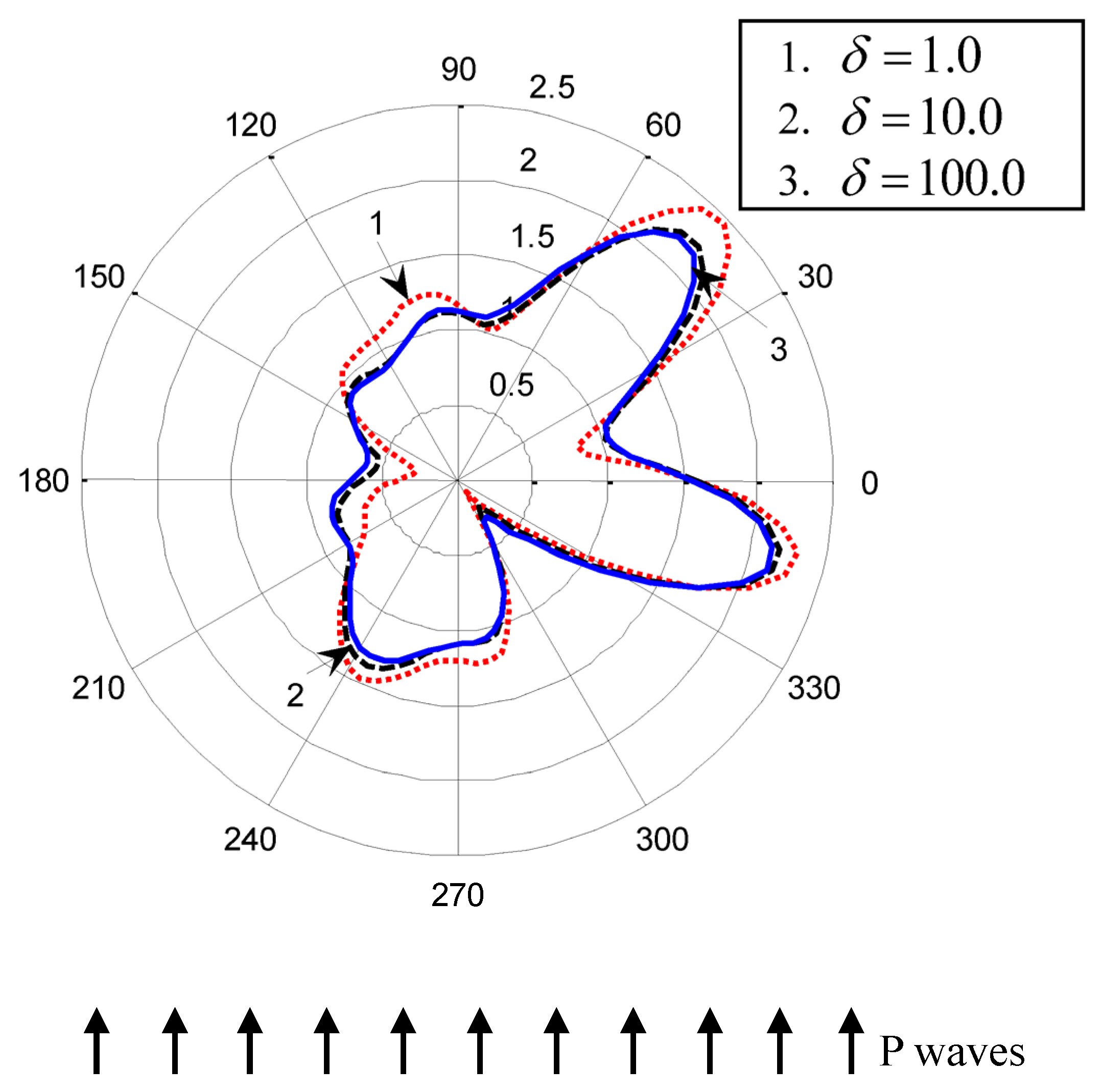
| Elastic Properties of Rock Mass | Elastic Properties of Concrete Lining | ||||
|---|---|---|---|---|---|
| 35 | 2.73 | 0.3 | 30 | 2.5 | 0.25 |
| R | |||||
|---|---|---|---|---|---|
| 4.33 | 0.93 | –0.0246 | –0.0834 | –0.0521 | –0.0418 |
Disclaimer/Publisher’s Note: The statements, opinions and data contained in all publications are solely those of the individual author(s) and contributor(s) and not of MDPI and/or the editor(s). MDPI and/or the editor(s) disclaim responsibility for any injury to people or property resulting from any ideas, methods, instructions or products referred to in the content. |
© 2023 by the authors. Licensee MDPI, Basel, Switzerland. This article is an open access article distributed under the terms and conditions of the Creative Commons Attribution (CC BY) license (https://creativecommons.org/licenses/by/4.0/).
Share and Cite
Jin, H.; Liu, X.; Zhou, J. Visco-Elastic Interface Effect on the Dynamic Stress of Symmetrical Tunnel Embedded in a Half-Plane Subjected to P Waves. Symmetry 2023, 15, 1434. https://doi.org/10.3390/sym15071434
Jin H, Liu X, Zhou J. Visco-Elastic Interface Effect on the Dynamic Stress of Symmetrical Tunnel Embedded in a Half-Plane Subjected to P Waves. Symmetry. 2023; 15(7):1434. https://doi.org/10.3390/sym15071434
Chicago/Turabian StyleJin, Hexin, Xiaomin Liu, and Junlong Zhou. 2023. "Visco-Elastic Interface Effect on the Dynamic Stress of Symmetrical Tunnel Embedded in a Half-Plane Subjected to P Waves" Symmetry 15, no. 7: 1434. https://doi.org/10.3390/sym15071434






